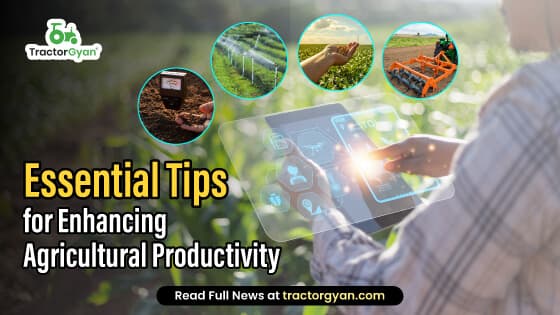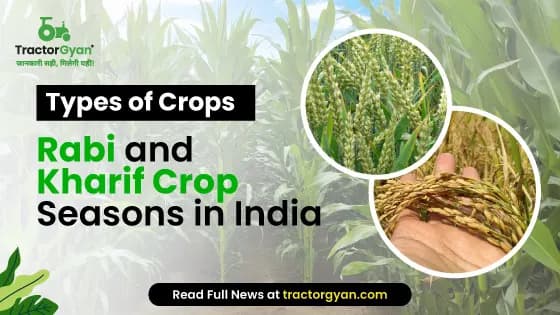Essential Tips for Enhancing Agricultural Productivity
टेबल ऑफ कंटेंट
Are you tired of seeing low agricultural productivity? Do you want to make a difference and help improve the situation? Then, it's time to take action and implement some effective tips to boost agriculture productivity in India. However, with a growing population and increasing demands, it has become imperative to enhance agricultural productivity to meet the ever-rising food requirements.
Today we will delve into a topic of utmost importance to the farming community: tips for farmers to boost their agricultural productivity effectively. Agriculture plays a pivotal role in sustaining our society, and by implementing these modern farming techniques and precision farming methods, farmers can optimize their output and contribute to the overall growth of the agricultural sector. Let's explore some key tips that can help farmers achieve higher productivity levels.
However, the sector faces numerous challenges, including low productivity levels. To address this issue, it is crucial to identify the dos and don'ts for increasing agricultural productivity in India. This blog not only aims to shed light on effective strategies but also highlights potential pitfalls that should be avoided.
So, let's begin!
Strategies for Enhancing Agricultural Productivity in the Farming Community
1. Embrace Modern Farming Techniques

To enhance agricultural productivity, farmers should embrace modern farming techniques and technologies. This includes advanced machinery, precision farming methods, and adopting innovative irrigation systems. By incorporating these modern practices, farmers can streamline their operations, reduce manual labour, and achieve higher yields and better agricultural products.
2. Soil Health Management

Maintaining soil health is crucial for sustainable agricultural productivity. Farmers should regularly assess the nutrient content and pH levels of their soil. By employing appropriate fertilization techniques and crop rotation methods, farmers can ensure that their soil remains fertile and capable of supporting healthy plant growth. Additionally, soil erosion prevention measures, such as contour ploughing and terracing, should be implemented to safeguard the soil's integrity for better agricultural products.
3. Efficient Water Management

Water scarcity is a growing concern in many regions, making efficient water management essential for farmers. Implementing drip irrigation systems, rainwater harvesting techniques, and utilizing water-saving technologies can significantly reduce water wastage. By optimizing water usage, farmers can ensure that their crops receive adequate hydration while conserving this precious resource.
4. Crop Selection and Diversification

Choosing the right crops and diversifying the farm's produce can increase agricultural productivity. Farmers should consider factors such as market demand, climate suitability, and crop rotation benefits when selecting crops. Diversifying the farm's produce not only mitigates risks associated with crop failure but also opens up opportunities for market expansion and increased profitability.
5. Pest and Disease Management

Pests and diseases can severely impact agricultural productivity. Farmers should adopt integrated pest management techniques, which involve a combination of preventive measures, biological controls, and judicious use of pesticides to keep the agricultural products safe. Regular monitoring of crops and timely intervention can help minimize the damage caused by pests and diseases, ensuring healthier and more productive harvests.
6. Continuous Learning and Knowledge Sharing

To stay ahead in the ever-evolving agricultural landscape, farmers should actively engage in continuous learning and knowledge sharing. Attending workshops, seminars, and agricultural fairs can provide valuable insights into the latest farming practices, technologies, and market trends. Collaborating with fellow farmers and sharing
7. Interplanting or Intercropping

Interplanting or intercropping is a method of planting more than one plant over a space of land which further ensures greater or maximum productivity and saves space.
By giving a home to a range of insects, soil creatures, and other organisms that fix nitrogen and other important nutrients in the soil that are lacking in single-crop environments, intercropping also promotes good biodiversity and better agricultural products.
If a crop fails due to unforeseeable weather conditions, intercropping or interplanting also serves as crop insurance. The dense canopy cover also conserves soil and reduces weed growth. Additionally, it will guarantee improved usage of fertilizers and nutrients that might otherwise be lost to runoff and leaching. Alternate strips of land that run perpendicular to the slope can also be planted with crops to prevent soil erosion and depletion.
8. Introduce land reform strategies

Land reforms are the first and most important step toward increasing production. Land reform is accomplished using tractors, machinery, and tools. These devices have the characteristics that make difficult farming terrain easy to work in the field successfully. Working in the field is simple, therefore increasing production is simple as well. The most effective way to boost production is through land reform.
9. Enhancing Market Linkages

Efficient market linkages are essential for farmers to receive fair prices for their produce. Strengthening agricultural infrastructure, such as storage facilities, transportation networks, and market information systems, can help reduce post-harvest losses and ensure timely access to markets. Encouraging the formation of farmer-producer organizations and promoting direct marketing channels can empower farmers to negotiate better prices.
10. Access to credit

Lack of access to credit is a major challenge for small and marginal farmers. The government should provide easy access to credit and insurance to farmers to help them cope with crop failures and other risks.
Although along with positives there are certain hindrances which do not lead to agricultural productivity or growth in India these are as follows:
1. Uncertain monsoon or uneven climatic conditions cause a greater factor in stopping the agricultural productivity fluctuations in yields and inadequacy in rainfalls doesn’t yield greater or maximum results as the climate is uncertain so growth is rarely predicted.
2. Poor implementation of farming practices Generation after generation, Indian farmers have continued to use antiquated and ineffective production techniques. Only when appropriate and sufficient manures are employed can production be increased. However, in India, the use of both farmyard manure and artificial fertilizers falls well short of what is required.
It is hardly necessary to emphasize the significance of high-quality seeds for raising agricultural productivity. However, Indian farmers have been utilizing very subpar seeds for decades.
3. Soil infertility or decline over the fertility of soil the primary kind of damage brought on by deforestation and unreliable agricultural methods like shifting cropping is soil erosion. Other causes of soil fertility loss include poor management and repetitive use, which increases salt, alkalinity, and aridity.
4. Old implements and traditional tools like wooden sickles, spades, and plods are frequently employed. Tractors and combines are not used as frequently. Agriculture is outdated because of the employment of these antiquated tools.
5. Cattle play a vital role in agriculture in India due to the country's limited mechanization. Most cattle are weak. The farmer must spend a lot of money on these. Tractor farming takes less time and money than cattle farming. Therefore, these also drive up the price of agriculture.
6. Indian land holdings are quite modest in size. The average size of a holding is 2.3 hectares, and 70% of holdings are much smaller. There are many holdings. The tiny properties make mechanized farming challenging. Implements and irrigation systems are not used effectively.
Dos and Don'ts for Increasing Agricultural Productivity in India
Do’s for increasing agriculture productivity in india
-
Embrace Technological Advancements
-
Promote Sustainable Farming Practices
-
Invest in Research and Development
-
Strengthen Farmer Education and Training
Don’ts for increasing agriculture productivity in India
1. Don't Neglect Soil Health:
One of the fundamental aspects of agricultural productivity lies in maintaining the health of our soils. Neglecting soil health can lead to decreased fertility, erosion, and reduced crop yields. It is essential to prioritize soil conservation practices, such as proper irrigation management, crop rotation, and the use of organic fertilizers. By doing so, we can preserve the long-term productivity of our agricultural lands.
2. Don't Overuse Chemical Inputs:
While chemical inputs can provide short-term benefits, their excessive and indiscriminate use can have detrimental effects on both the environment and human health. Over-reliance on chemical fertilizers and pesticides can lead to soil degradation, water pollution, and the emergence of resistant pests. Instead, we should promote integrated pest management techniques, organic farming practices, and the use of bio-fertilizers to ensure sustainable agricultural productivity.
3. Don't Ignore Water Management:
Water scarcity is a significant challenge faced by Indian agriculture. Ignoring proper water management practices can result in inefficient irrigation, water wastage, and reduced crop yields. Implementing efficient irrigation systems, such as drip irrigation and sprinklers, can help conserve water resources and improve agricultural productivity. Additionally, rainwater harvesting and water recycling techniques should be embraced to mitigate the impact of water scarcity.
4. Don't Disregard Crop Diversification:
Relying heavily on a single crop can make agricultural systems vulnerable to pests, diseases, and market fluctuations. Crop diversification plays a crucial role in enhancing resilience and reducing risks. By cultivating a variety of crops, farmers can minimize the impact of adverse weather conditions, pests, and market uncertainties. Moreover, diversification can also contribute to improved soil health and sustainable farming practices.
5. Don't Underestimate the Importance of Research and Innovation:
To achieve significant advancements in agricultural productivity, it is vital to invest in research and innovation. Neglecting the development and adoption of new technologies, improved crop varieties, and efficient farming practices can hinder progress
Conclusion
Improving agricultural productivity in India is crucial for the country's economic growth and food security. By implementing these tips, we can help farmers increase their yields, reduce costs, and improve their livelihoods. Moreover, adhering to proper agricultural practices is essential for the long-term sustainability of agriculture, the safety of our food supply, the economic viability of farming operations, and the social responsibility of farmers.
कैटेगरी
और ब्लॉग पढ़ें
Mumbai: AutoNxt Automation is looking to raise Rs 27 crore (USD 3.5 million) in pre-Series A funding round by October-November for the production of electric tractor and its launch, founder and CEO Kaustubh Dhonde said. Founded in 2016, the automation technology startup...
When the name agriculture pops up it becomes a compulsion to talk and know about pesticides.
Pesticides are substances or say a mixture of substances of chemical or biological ingredients which are used to destroy, control, or repair the damages caused...
Looking for a fruit that you can cultivate easily and earn a great profit margin? Try dragon fruit cultivation in India. Because of its huge demand in the market, the cultivation of Dragon fruit has become a great cultivation option.
In this blog,...
इसके बारे में अपनी टिप्पणी लिखें Essential Tips for Enhancing Agricultural Productivity
.webp&w=1920&q=75)
ट्रैक्टर और कृषि से जुड़े सबसे अधिक खोजे जाने वाले ब्लॉग्स
30 Jul 2025
30 Jul 2025
29 Jul 2025
08 Sep 2025
03 Jul 2025
30 Jul 2025
30 Jul 2025
30 Jul 2025
29 Jul 2025
30 Jul 2025
29 Sep 2025
31 Jul 2025
30 Jul 2025
31 Jul 2025















.webp&w=2048&q=75)










.webp&w=2048&q=75)
.webp&w=2048&q=75)



























